
Six teams are still fighting to get to Round 2, but after 40 games, the NBA playoffs have taught us so much. Here are the most important lessons we’ve gleaned from the second season.
1. LeBron stays king, but Giannis is the future.
Juliet Litman: LeBron James solidified his claim to the 2017 Playoffs MVP in Game 3 against the Pacers. At the end of his 14th season, he found another record to conquer by leading the Cavs to a win in a road game in which they trailed by 26 points. It was the largest comeback in playoffs history. Congrats, LeBron. You’re still making history. He carried them as he has all season, making it OK for Cleveland to largely pass on playing first-half defense in all four games. That’s a luxury of having the best player, maybe ever, on your team.
Giannis Antetokounmpo nearly matched LeBron’s feat. His Milwaukee Bucks were down 25 at home in an elimination game, and he nearly brought them back. The biggest revelation of this round is that he’s even closer to superstardom than even his most astute watchers realized, but he’s not quite there yet. The Bucks did regain a two-point lead, but Giannis was too gassed and too inexperienced to seal a win and push the series to seven. He probably won’t pass up a 3 in the final seconds of an elimination game ever again. And when LeBron decides he’s done snatching up every record of meaning or 12 consecutive trips to the postseason catch up with him, Giannis will be ready. He’s not the MVP yet, but he will be eventually. I can’t wait.
2a. The Thunder need to flip Enes Kanter for shooters.
Kevin O’Connor: In Oklahoma City’s first-round loss to the Rockets, Russell Westbrook dominated the ball more than Michael Jordan in Space Jam. Westbrook’s playoff usage of 45.8 was higher than MJ on the Tune Squad against the Monstars. Jordan had an excuse for his ball-hogging: He was teamed up with Bill Murray, Newman from Seinfeld, and a bunch of Looney Tunes characters. He’s also the GOAT.
Russ has unexceptional teammates, but they have individual skill sets that weren’t maximized: Russ ignored a wide-open Doug McDermott, blocked Jerami Grant’s putback dunk, and forced wild drives rather than dumping it off to a cutting Steven Adams.
The Thunder will never win this way, and you shouldn’t be surprised if you’re interested in NBA history. As highlighted before the season, there have been only 19 instances ever in which a player finished a season with a usage of 35 or higher, per Basketball-Reference. Only one led his team to the Finals (Allen Iverson’s 2001 76ers) and seven missed the playoffs entirely. Russ became the sixth to lose in the first round. High-usage players are exhilarating, but their teams flame out.
Philosophical changes need to be made, though it might be hard for Westbrook to go back to sharing after being given the go-ahead to do whatever he wants. They need to stockpile shooters to increase floor-spacing, and (hopefully) encourage better ball movement. They won’t have cap space this summer, but they could always look to flip Enes Kanter. They also have their first-round pick (no. 21), which I’d use to target quality shooters who can double as secondary ball handlers, like Luke Kennard, Jawun Evans, Derrick White, and Josh Hart.
The Thunder can’t let Westbrook do it all by himself, otherwise each season will end on the same sour note.
2b. The Thunder needed Reggie Jackson.
Chris Ryan: During his time in Oklahoma City, Reggie Jackson was probably more popular in the Pacers’ locker room than he was the Thunder’s.
But you can’t tell me that OKC couldn’t have used a secondary ball handler or playmaker in its series against Houston. Of all the good-to-great players who have left Oklahoma City over the years, the Pistons point guard is an afterthought, mostly because he never seemed that well-liked in the first place. He wanted to start, he wanted the ball, and he wanted his money. I get it.
The problem with not wanting to pay Reggie is paying Enes Kanter. You can’t play Kanter! This is what Reggie is getting paid in Detroit; this is what Kanter is getting paid in OKC. The more I think about it, the more puzzled I am by the team Sam Presti built. The Thunder traded for Taj Gibson even though they had Steven Adams, Enes Kanter, and Domantas Sabonis. They dealt Cam Payne, even though they had … Semaj Christon? The Thunder needed a Reggie, or a Brandon Jennings, or a Patty Mills, or a Deron Williams. They paid for it with their playoff lives.
3. A team can never have too many wings.
Jonathan Tjarks: The Bucks raced out to a 2–1 series lead against the Raptors by starting four wings together, and Toronto regained control of the series by swapping out its starting center (Jonas Valanciunas) for another wing (Norman Powell). Threes are playing as 4s across the league: The Celtics are starting Jae Crowder as a small-ball power forward, and the Jazz are finishing games with Joe Johnson at that spot. You can never have too many Swiss army knives in your rotation these days, which is one of the main reasons the Warriors are such overwhelming favorites to win it all.
4. Rajon Rondo is the best advance scout in the NBA.
Danny Chau: Rondo has always had an uncanny ability to recognize and conceptualize patterns that others don’t see. Remember when he was an ad hoc algebra teacher in 2012? I won’t try to put into words how he solved “5X = 70,” but I’ll say I tried it his way and my mind crossed itself up like:
The way he can instruct people to see what he sees begins to explain the way he helped the Bulls win the first two games of the Celtics series. An advance scout gathers as much information about a future opponent as possible, outlining tendencies, weaknesses, and strengths that can then be taken to the players and coaching staff to help with preparation. Many players are smart enough to gather a lot from an opponent by feel, but an advance scout helps fill in the blanks in a game where the margin for error can be slim.
It’s one thing to react to a set you’ve seen before on film. It’s another thing to recognize plays before they happen, the way a scout might, and be on the floor to help your teammates position themselves exactly where they need to be in real time. The Bulls don’t look this good on defense without him:
Those first two games proved that there’s still a few chapters left in the NBA’s Rondo story — transforming into a roving Svengaliesque coach on the floor for the rest of his career could be interesting.
5. Depth matters, even when rotations are tightened.
O’Connor: Utah’s depth has been the difference against the Clippers. Joe Johnson, now 35 years old, is Utah’s MVP. Watching Joe Ingles play defense is like listening to Tommy with a candle burning. Rodney Hood is contributing. They won a game without Rudy Gobert. “We’ve got a lot of guys that are coming off the bench that have been starters,” Jazz head coach Quin Snyder said after their Game 5 win. “For me, I’m not really differentiating who’s coming off the bench and who’s starting the game.”
Must be nice. Doc Rivers doesn’t have the same luxury. Look at their roster. You see one of the greatest point guards ever in Chris Paul, one of the greatest shooters ever in J.J. Redick, one of the league’s best interior players in DeAndre Jordan. Then it’s a wasteland of nothingness: an old Raymond Felton, washed-up Paul Pierce, Warriors reject Marreese Speights, Doc’s son (who just returned from injury), and a bunch more JAGs like Brandon Bass and Wesley Johnson. Jamal Crawford is the only bench option Doc can even feel pretty good about, and he’s a nonfactor if he’s not scoring.
The Jazz are outscoring the Clippers by 16.5 points per 100 possessions when Gordon Hayward is off the floor. The Clippers are getting outscored by 10.8 points per 100 possessions when Chris Paul is off the floor. L.A.’s bench was a problem even before Blake Griffin got hurt, just like it has been ever since Doc took over as general manager and head coach. This summer, Doc actually needs to address the issue, or we’ll be writing this same story again next April or May.
6. The Celtics are the least intimidating no. 1 seed … ever.
Chau: Boston’s probably pulling off the back-end sweep after losing their first two games at home. Winning four in a row would be a feat worthy of praise, but even then, the Celtics have done nothing to dissuade skeptics from seeing them as just another team in the morass of Eastern Conference mediocrity. Would-be LeBron slayers in the Bulls and Pacers of the past at least produced a certain level of anticipation to their eventual playoff losses. At this point, I’m not sure if the Celtics would even be the favorites in the second round.
7. Coaches have found a new arena to fight with referees.
Jason Concepcion: Today’s coaches, working in the meme era, have figured out how to game the refs. Fizdale was the pioneer. Attach a hook to your anti-ref screed and you’ve got a hot bar. In fact, he gave us two: “They not gonna rook us” and the semi-ambiguous “take that for data.” Fred Hoiberg pushed this game forward and tightened up his “Isaiah discontinues” jab by flat-walking off the podium. In the modern postgame game, hooks can be wordless.
8. The game isn’t over until after the press conference.
Litman: A brief list of the most newsworthy moments so far:
- Paul George calling out CJ Miles for taking the last shot in Game 1
- Fred Hoiberg accusing Isaiah Thomas of carrying the ball
- Hoiberg leaving his session abruptly when asked about Thomas after a subsequent game
- Chris Paul rejecting a (dumb) question
- Russell Westbrook refusing a question directed at Steven Adams
- Patrick Beverley pointing to Westbrook’s number of shot attempts
- David Fizdale declaring, “They not gonna rook us”
None of these events transpired on the court, but they all determined story lines for games that came after. The postgame press conference is not just an obligation, it’s an extension of gamesmanship. It’s a place to set the agenda, to steer the narrative, to exude confidence. Choose your words wisely.
9. Never get into a post battle with Zach Randolph.
Tjarks: Z-Bo can be exposed by a smaller and faster team that spreads the floor and forces him to guard in space, but you aren’t beating him by pounding the ball inside and wrestling for boards. That’s what LaMarcus Aldridge discovered in the first round, as the Spurs star looked like a shell of himself trying to deal with the wily tricks and outright brutality that define Randolph’s game. This is not the first time Aldridge has struggled with Z-Bo: He shot 33 percent from the field on the Blazers in their first-round loss to the Grizzlies in 2015.
10. Lance Stephenson would survive and thrive in the apocalypse.
Chau: The Pacers were desperate to survive the postseason cut, so they brought Lance back, and he rewarded them with the no. 8 seed and a version of himself — one that flashed All-Star–caliber production — we hadn’t seen in years. But it was a Faustian bargain: You don’t get that Lance unless you cede everything to him on the floor. Most teams couldn’t stomach giving him free rein over an offense, but Indiana had developed the palate for Stephenson’s brand of lawlessness. In the end of days, Lance will definitely be there to offer a helping hand. And he will take what is his.
11. Joe Ingles is awesome.
Tjarks: Most of the discussion about Utah’s coming offseason has centered on the impending free agency of both Gordon Hayward and George Hill, but Joe Ingles has increased his asking price as well. He has firmly established himself as Utah’s starting shooting guard (sending Rodney Hood to the bench) and he has outplayed J.J. Redick in the first-round series against the Clippers. He’s doing a little bit of everything — averaging 6.8 points, four rebounds, five assists, and 1.6 steals a game — and making Doc Rivers, who cut him in the preseason in 2014, look more than a little foolish.
12. Tony Parker and Manu Ginobili are barely relevant.
O’Connor: Tony Parker and Manu Ginobili are 34 and 39 years old, respectively, and sometimes they play like it. Ginobili was a complete no-show except for his 10-point explosion in Game 5, while Parker was up and down all series until his Game 6 excellence. Patty Mills has helped fill in the blanks, but I can’t stop thinking about the guy who’s not playing: Dejounte Murray.
The Spurs drafted him 29th pick in last year’s draft. He has logged only nine minutes this postseason, but has size. He’s fast. He’s flashy. He’s not afraid of the moment. He might be the next Spurs project. Parker isn’t done yet, but don’t be surprised next year when the Spurs are in the playoff for the 21st consecutive season, and Murray is manning the point.
13. Counterpoint: Tony Parker is not done.
Shea Serrano: I will concede that Tony Parker, this season, has averaged fewer points per game than any other year in the league minus his rookie season. And I will concede that Tony Parker, this season, tied his previous career low for steals. And I will concede that Tony Parker, this season, averaged the second-fewest assists per game for his career. And I will concede that Tony Parker, this season, averaged his fewest ever rebounds per game. And I will concede that Tony Parker, this season, averaged fewer free throws than in any of his other seasons. And I will concede that Tony Parker, this season, and especially in these playoffs against the brilliant Mike Conley, has moved on defense with the mobility of a refrigerator. But this is what I will not concede: that Tony Parker is done.
Tony Parker can’t be done because Tony Parker isn’t done — especially not after pouring in 27 points to close out the Grizzlies. He gets to choose that. He has four championship rings and a Finals MVP. There’s a championship code of conduct that we all must abide by. If I’d have told every Spurs fan, “Hey, listen. You get to have this player and he’s going to help you win four titles and also he’ll even get a Finals MVP, but in exchange you’re going to have to put up with, like, three or four years of him not being able to keep up,” that’s a thing you take every time. You don’t get to change your mind now. It’s fine. We’ll all be fine. Let Tony Parker be. He’s done when he’s done.

